2019 MERCEDES-BENZ CLA COUPE winter tires
[x] Cancel search: winter tiresPage 63 of 330
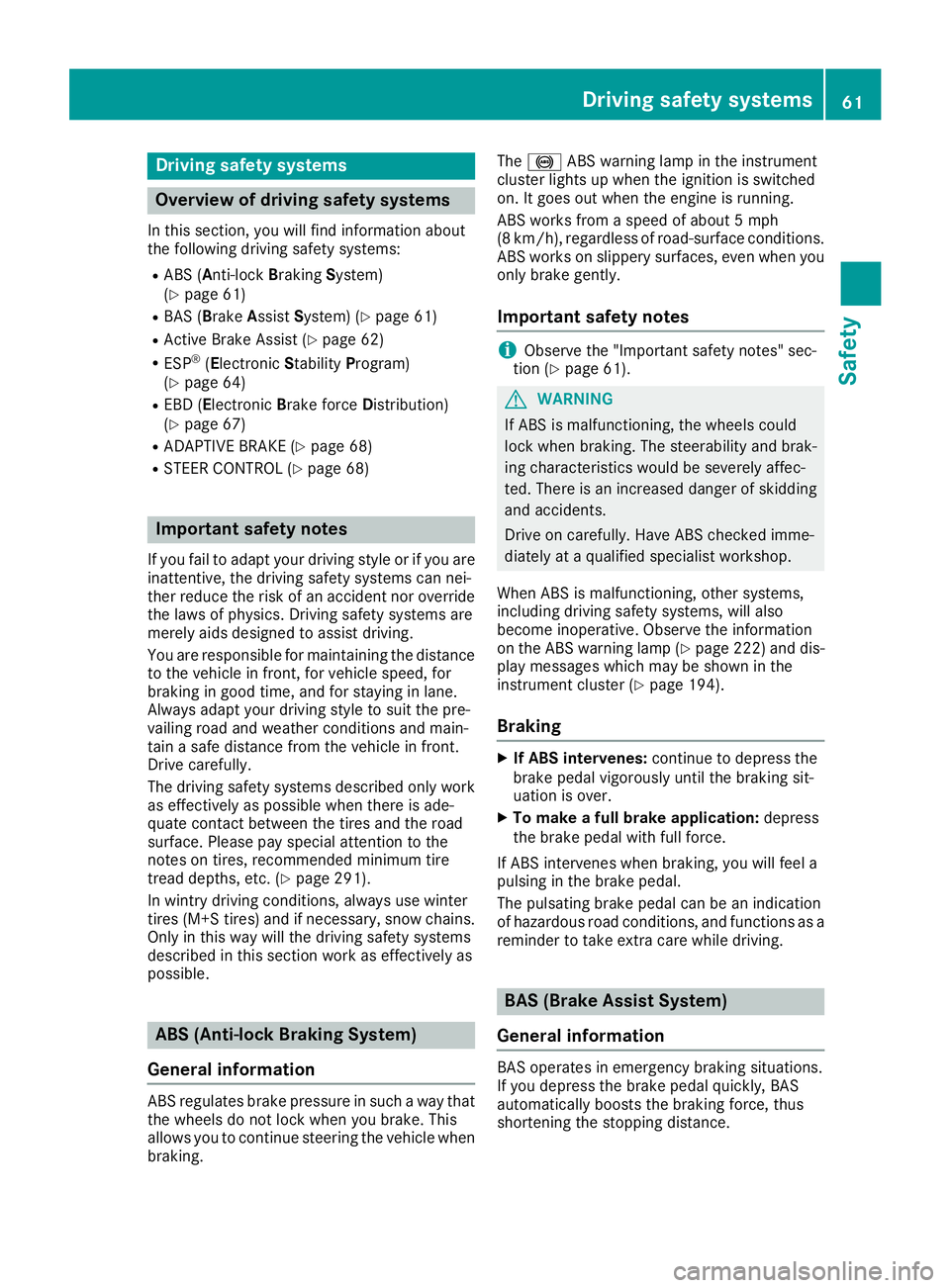
Dri
vin gsa fet ysys tems Over
view ofdrivin gsa fet ysys tems
In this sec tion ,you willfindinfo rm ation about
th efo llow ing dri vin gsaf etysys tems :
R AB S(An ti-loc kBrak ing Syst em)
(Y page 61)
R BA S(Brak eAss istSyst em) (Ypage 61)
R Ac tive Brak eAs sis t(Y page 62)
R ES P®
(E lec tron icStabili tyProgr am)
(Y page 64)
R EB D(Elect ronicBrak efo rc eDist ribution )
(Y page 67)
R AD APTIV EBRA KE(Ypage 68)
R ST EERCON TROL (Ypage 68) Im
por tant safet ynot es
If you failtoadapt yourdrivin gst yle orifyou are
in at te nt ive ,th edri vin gsaf etysys tems can nei-
th er red uce theris kof an acc iden tno rov err ide
th elaws ofphys ics. Dr iving safetysys tems are
mer elyaids designed toass istdrivin g.
You arerespon sibleformain tainingth edis tanc e
to theveh icle in fron t,forveh icle spe ed, for
bra king ingoo dtime, andforst ayin gin lan e.
Al ways adapt yourdrivin gst yle tosuit thepre -
vail ing ro ad and weat hercond ition sand main -
ta in asaf edis tanc efrom theveh icle in fron t.
Dr ive carefully.
The drivin gsaf etysys tems described onlywor k
as effect ive lyas pos siblewhen there isade-
quat eco ntact between thetires and thero ad
sur face.Plea sepay special atte nt ion tothe
no teson tires ,rec ommen dedminimum tire
tr ead dept hs,etc. (Y page 291).
In win try dri vin gco nd ition s,always usewinter
ti res (M+ Stires )and ifnece ssary,snow chains.
Onl yin thi swa ywi llthe driving safety system s
de scri bedin thi ssecti onworkas effe ctive lyas
po ssi ble. ABS
(Anti -lock Brakin gSys tem)
Gen eral informati on ABS
regulate sbra kepre ssu reinsu ch awa ytha t
the wheelsdo not lock when youbra ke. This
al lo ws youto conti nuestee ringthevehiclewh en
bra king . The
0025 ABSwarning lamp inthe instrum ent
clu ster lights upwhen the igniti onissw itch ed
on. Itgoe sou twh en the engi neisrunning .
ABS works from aspe edofabou t5 mph
(8 km/h ),reg ard less ofroa d-su rface cond itions.
ABS works onslip pe rysurfa ces, evenwh en you
onl ybra kegentl y.
Impo rtant safetynotes i
Obs
erve the"Impo rtant safety notes "sec-
tio n(Y page 61). G
WAR
NING
If ABS isma lfunctio ning,the wheelscou ld
lo ck when bra king .The stee rability and brak-
ing characteri stic swo uld be sev erelyaff ec-
ted .The reisan incre ased danger ofski dding
and accidents.
Driv eon car efully. Hav eABS checked imme-
di ate lyat aqu alifi ed spe cialist wo rksh op.
Whe nABS isma lfunctio ning,othe rsy stem s,
incl uding driving safety system s,willal so
be come inoperati ve. Obs erve theinforma tion
on the ABS warning lamp (Ypage 222 )and dis-
pl ay mes sages which maybe sho wninthe
ins trum entcluster (Ypage 194 ).
Brakin g X
IfABS interv enes:conti nuetodepre ssthe
bra kepedalvig oro uslyunti lthe braking sit-
ua tio nis ove r.
X To make aful lbrake application:de pre ss
the brakepedalwi th fullforce .
If ABS intervene swh en bra king ,yo uwi llfee la
pu lsing inthe brakepedal.
The pulsati ng bra kepedalcan beanind ication
of ha zard ousroa dcond itions, andfunc tions asa
rem inderto take extra carewh ile dri ving . BAS
(Brak eAs sist Sys tem)
Gen eral informati on BAS
opera tes ineme rgency braking situa tions.
If yo ude pre ssthe brakepedalqu ickl y,BAS
au toma tically bo osts thebraking force ,thu s
sho rteni ngthe stop ping dista nce. Dri
ving safe tysys tems
61Safety Z
Page 152 of 330
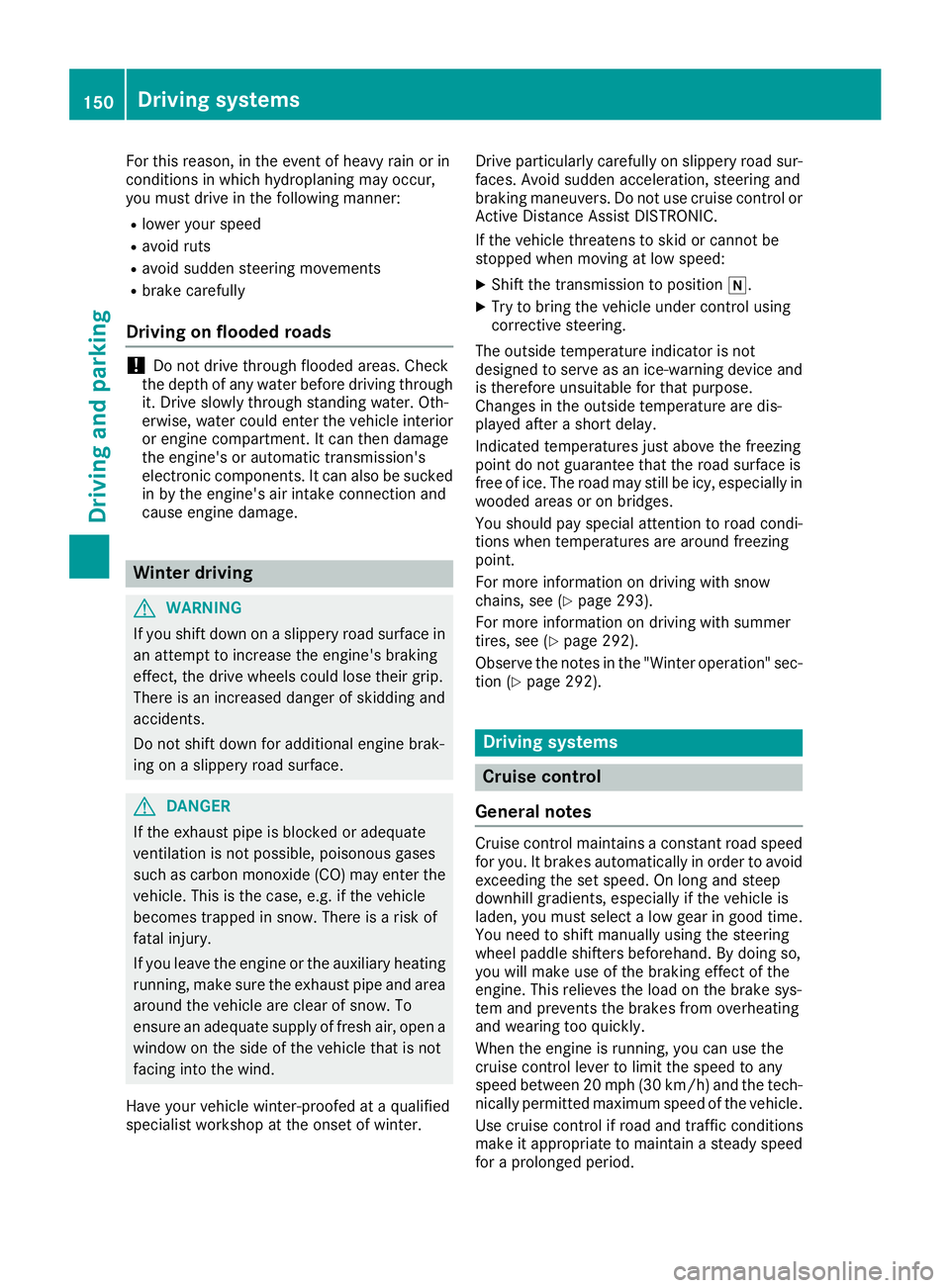
For
this reason, inthe event ofhea vyrainor in
condi tions inwhi chhydrop laning mayoccur ,
yo umus tdri ve inthe follow ing manne r:
R low eryour spe ed
R avo idruts
R avo idsud den steer ingmove ments
R bra kecare fully
Dri vin gon floode droads !
Do
not drive throu ghfloode dare as. Che ck
the depthofany water befo redri ving throu gh
it. Drive slowlythrou ghstand ingwater. Oth-
erw ise,wa ter cou ldenter thevehi cleinteri or
or engi necompa rtment. Itcan then damag e
the engi ne's orautoma tictransmi ssion's
ele ctronic components.Itcan also be sucke d
in by the engi ne's airintake connectio nand
cau seengi nedamag e. Win
terdrivi ng G
WARNI
NG
If yo ushi ftdow non asli ppe ryroa dsur face in
an attemp tto increa sethe engi ne's braking
effe ct,the drive whe elscou ldlos ethei rgri p.
The reisan increa seddanger ofskid ding and
acci dents.
Do not shiftdow nfor additi onal enginebra k-
ing onasli ppe ryroa dsur face . G
DA
NGER
If the exha ustpipeis blo cked oradequ ate
ventil ation isnot possible, poi sonou sga ses
such ascarb onmonoxi de(CO) may enter the
vehi cle. Thisis the case ,e.g. ifthe vehi cle
beco mestrapped insnow .The reisarisk of
fata linjur y.
If yo ulea vethe engi neorthe auxili ary hea ting
runni ng,make surethe exha ustpipeand area
aro und thevehi cleare clea rof snow .To
ensu rean adequ atesupplyoffresh air, ope na
wi ndow onthe sideof the vehi clethat isnot
faci nginto thewind.
Have your vehi clewinter-pro ofedataqu alifi ed
spe cialist wor kshop atthe onset ofwinter. Drive
particu larly care fullyon slippe ryroa dsur -
face s.Avoid sudden acce leration, steer ingand
bra king mane uvers.Do not use cruisecontrol or
Active DistanceAssistDISTR ONIC.
If the vehi clethrea tenstoskid orcannot be
stopp edwhe nmovi ngatlow speed:
X Shift thetransmi ssion topos ition005C.
X Try tobring the vehi cleund ercontrol using
corre ctive steering.
The outsid etempe ratureindi cator isnot
des igne dto serve asan ice-w arningdevi ceand
is there foreunsu itable forthat purpos e.
Cha nges inthe outsid etempe ratureare dis-
pla yedafte ra shor tdel ay.
Indi cated tempe raturesjust above thefree zing
poi ntdo not guara ntee thattheroadsur face is
free ofice. The roadmay stillbe icy,esp ecia lly in
woo ded areasoron bridge s.
You shou ldpa yspe cialattenti ontoroa dcondi -
tions whentempe raturesare around freezing
poi nt.
For more informationondriving with snow
chai ns,see (Ypage 293).
For more informationondriving with sum mer
tires ,see (Ypage 292 ).
Obs erve thenotes inthe "Winter operation" sec-
tion (Ypage 292 ). Dri
vin gsys tems Crui
secontrol
Gen eral notes Cru
isecontrol maintains aconsta ntroa dspe ed
for you. Itbra kes automa tically in orde rto avo id
excee dingthesetspeed. Onlong andsteep
dow nhillgra dients, especia lly if the vehi cleis
la den, youmus tsel ect alow gearin goo dtime.
You need toshi ftmanu ally usi ng the steer ing
whe elpa ddl eshi fters beforeha nd.Bydoing so,
yo uwi llmake useofthe braking effectof the
engi ne.Thisrel iev es the loadon the brakesys-
tem andprevents thebrakes from overheating
and wearing too quickly .
Whe nthe engi neisrunni ng,youcan usethe
crui secontrol leverto limit the speedtoany
spe edbetw een20mph (30km/h )and thetech-
nica lly per mitted maximum speedofthe vehi cle.
Use cruisecontrol ifroa dand traffi ccondi tions
make itap prop riate to mai ntain astea dyspe ed
for aprol onge dper iod. 150
Dri
vin gsys temsDrivin gand parking
Page 268 of 330
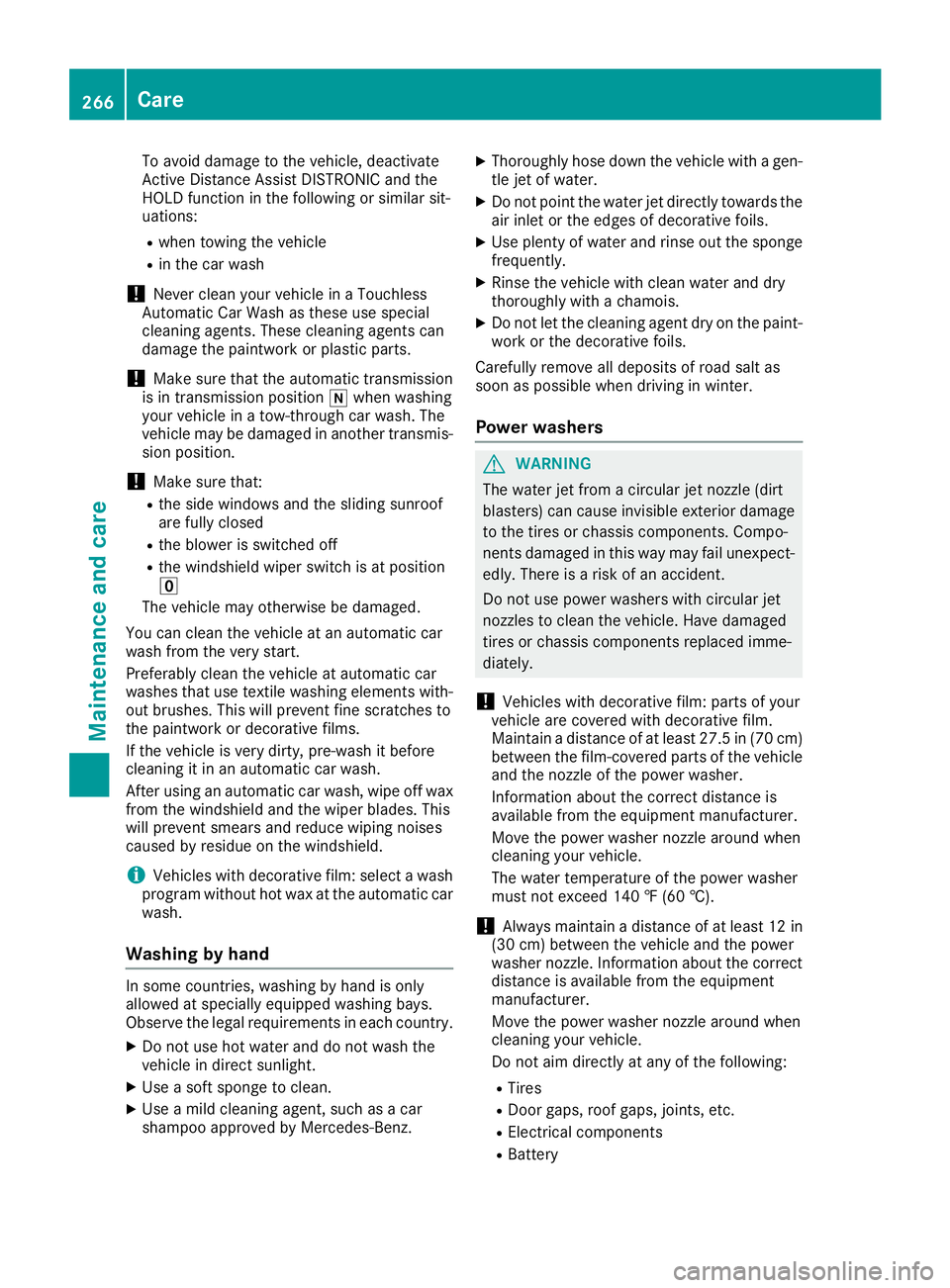
To
avoid damage tothe vehicle, deactivate
Act ive Distan ceAssist DISTRONIC andthe
HOLD functioninthe following orsimilar sit-
uations:
R when towing thevehicle
R in the carwash
! Never
cleanyourvehicle inaTouchless
Automat icCar Wash asthese usespecial
cleaning agents.Thesecleaning agentscan
damage thepaintwork orplastic parts.
! Make
surethattheautomatic transmission
is in trans mission position 005Cwhen washing
your vehicle inatow-t hrough carwash. The
vehicle maybedamaged inanother transmis-
sion position.
! Make
surethat:
R the side windows andthesliding sunroof
are fully closed
R the blower isswitched off
R the windshield wiperswitch isat position
0092
The vehicle mayotherwise bedamaged.
You canclean thevehicle atan automatic car
wash fromthevery start.
Preferably cleanthevehicle atautomatic car
washes thatusetextilewashing elements with-
out brushes. Thiswillprevent finescratc hesto
the paintwork ordecorative films.
If the vehicle isvery dirty, pre-wash itbefore
cleaning itin an automatic carwash.
Aft erusing anautomatic carwash, wipeoffwax
from thewindshield andthewiper blades. This
will prevent smearsandreduce wipingnoises
caused byresidue onthe windshield.
i Vehicles
withdecorative film:select awash
program withouthotwax atthe automatic car
wash.
Washing byhand In
some countries,washing byhand isonly
allowed atspecially equipped washingbays.
Observe thelegal requirement sin each count ry.
X Do not use hotwater anddonot wash the
vehicle indirect sunlight.
X Use asoft sponge toclean.
X Use amild cleaning agent,suchasacar
shampoo approved byMercedes- Benz. X
Thoroughly hosedown thevehicle withagen-
tle jet ofwater.
X Do not point thewater jetdirectly towards the
air inlet orthe edges ofdecorative foils.
X Use plenty ofwater andrinse outthesponge
frequent ly.
X Rinse thevehicle withclean water anddry
thoroughly withachamois.
X Do not letthe cleaning agentdryonthe paint-
work orthe decorative foils.
Carefully removealldeposits ofroad saltas
soon aspossible whendriving inwinter.
Power washers G
WARNIN
G
The water jetfrom acircular jetnozz le(dirt
blasters) cancause invisible exteriordamage
to the tires orchassis compon ents.Compo-
nent sdamaged inthis way may failunexpect -
edly. There isarisk ofan accident .
Do not use power washers withcircular jet
nozz lestoclean thevehicle. Havedamaged
tires orchassis compon entsreplaced imme-
diately.
! Vehicles
withdecorative film:parts ofyour
vehicle arecovered withdecorative film.
Maintain adistance ofat least 27.5in(70cm)
between thefilm-c overed partsofthe vehicle
and thenozz leof the power washer.
Infor mation aboutthecorrec tdistance is
availab lefrom theequipment manufacturer.
Move thepower washer nozzlearound when
cleaning yourvehicle.
The water temperat ureofthe power washer
must notexceed 140‡(60 †).
! Always
maintain adistance ofat least 12in
(30 cm) between thevehicle andthepower
washer nozzle.Infor mation aboutthecorrec t
distance isavailabl efrom theequipment
manufact urer.
Move thepower washer nozzlearound when
cleaning yourvehicle.
Do not aim directly atany ofthe following:
R Tires
R Door gaps, roofgaps, joints,etc.
R Elect ricalcompon ents
R Batt ery 266
CareMaintenance
andcare
Page 276 of 330
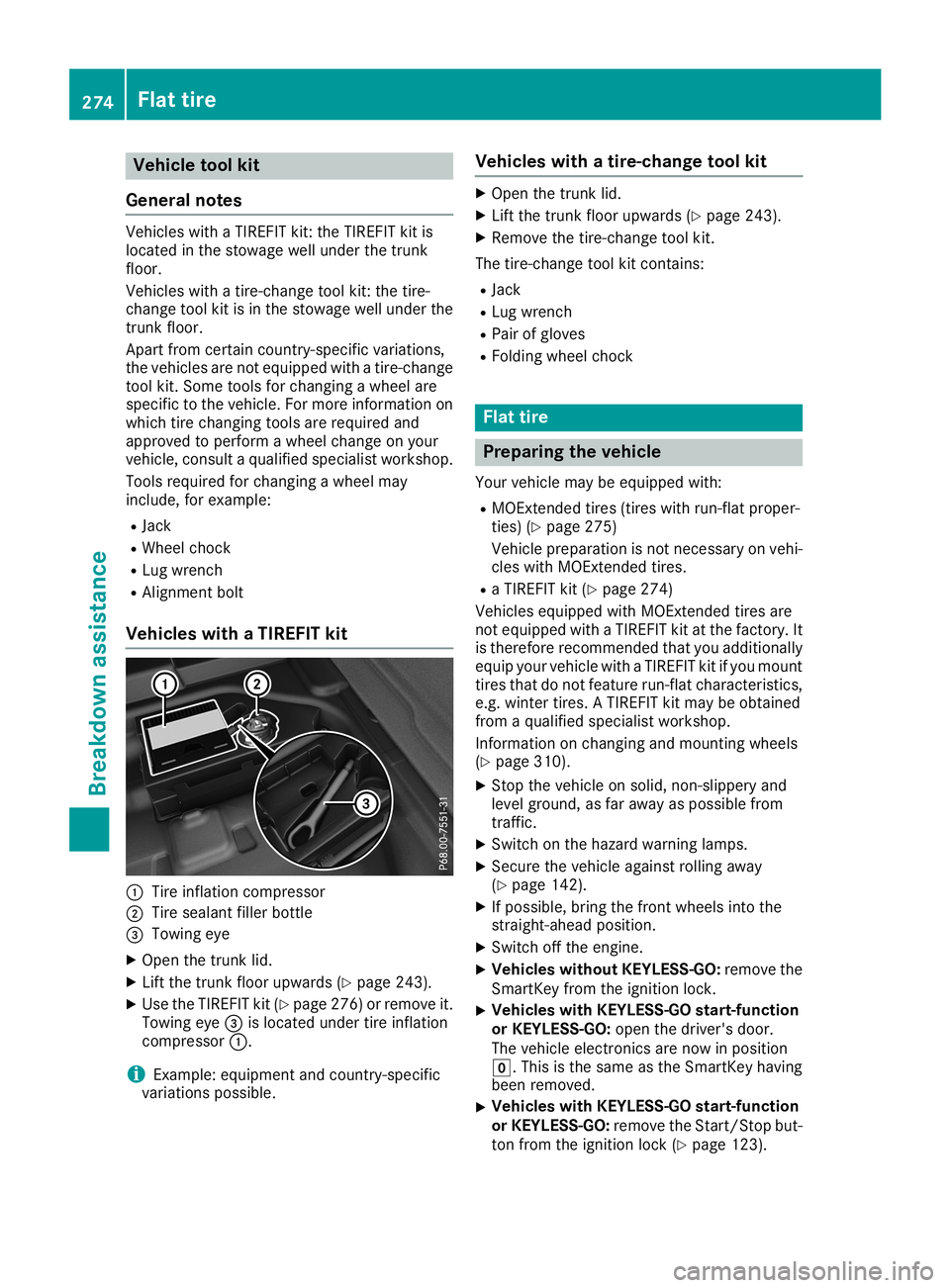
Vehi
cle too lkit
Gen eral notes Veh
icles with aTIR EFIT kit:the TIREFIT kitis
lo cate din the stow agewe llund erthe trunk
flo or.
Veh icles with atire -cha nge tool kit:the tire-
cha nge tool kitisin the stow agewe llund erthe
trunk floor.
Apa rtfrom certaincou ntry -spe cificvar iatio ns,
the vehicles are not equipp ed with atire -cha nge
tool kit.Some toolsfor cha nging awh eelare
spe cificto the vehicle. For more informa tionon
wh ich tire changing tool sare required and
ap pro ved toperfor mawh eelcha nge onyour
veh icle, consu ltaqu alifi ed spe cialist wo rksh op.
Too lsreq uired forcha nging awh eelmay
incl ude,for exa mpl e:
R Jack
R Whe elchoc k
R Lu gwre nch
R Ali gnme ntbolt
Vehi cles with aTIRE FITkit 0043
Tire infl ation comp ressor
0044 Tire sea lant fillerbo ttle
0087 Tow ingeye
X Ope nthe trunk lid.
X Lif tthe trunk floor upwa rds (Ypage 243) .
X Use theTIREFIT kit(Ypage 276 )orremove it.
Towi ngeye 0087islocated undertireinfla tion
compresso r0043.
i Example:
equipment andcountry-spe cific
varia tions possible. Vehic
leswith atire-chang etool kit X
Open thetrunk lid.
X Lift the trunk floorupwards (Ypag e243).
X Remo vethe tire-change toolkit.
The tire-change toolkitcontains:
R Jack
R Lug wrench
R Pai rof glove s
R Foldi ngwhee lchock Flat
tire Preparing
thevehic le
You rvehicl emay beequ ipped with:
R MOExtended tires(tires withrun-flat proper-
ties) (Ypag e275)
Vehicl eprepa ration isnot necessary onvehi-
cles with MOExtended tires.
R aTIREFIT kit(Ypag e274)
Vehicl esequ ipped with MOExtended tiresare
not equippedwith aTIREFIT kitatthe factory. It
is therefore recommended thatyouadditional ly
equ ipyou rvehicl ewith aTIREFIT kitifyou mount
tires thatdonot feature run-flat characteristics,
e.g. winter tires.ATIREFIT kitmay beobtai ned
from aqua lified specia listworkshop .
Information onchanging andmounting wheels
(Y pag e310).
X Stop thevehicl eon soli d,non-slipp eryand
level ground ,as far awa yas possi blefrom
traffic.
X Switch onthe hazard warninglamp s.
X Secure thevehicl eaga inst rolling awa y
(Y pag e142) .
X Ifpossi ble,bring thefront wheelsinto the
straigh t-ahead position.
X Switch offthe engine.
X Vehic leswitho utKE YLESS-GO :remove the
SmartKey fromtheignitio nlock.
X Vehic
leswith KEYLESS-GO start-function
or KEYLESS-GO :open thedriver' sdoor.
The vehicl eelectronics arenow inposi tion
005A. This isthe same asthe SmartKey having
been removed .
X Vehic
leswith KEYLESS-GO start-function
or KE YLESS-GO :remove theStart/Stop but-
ton from theignitio nlock (Ypag e123). 274
Fl
at tireBreakdown assistance
Page 277 of 330
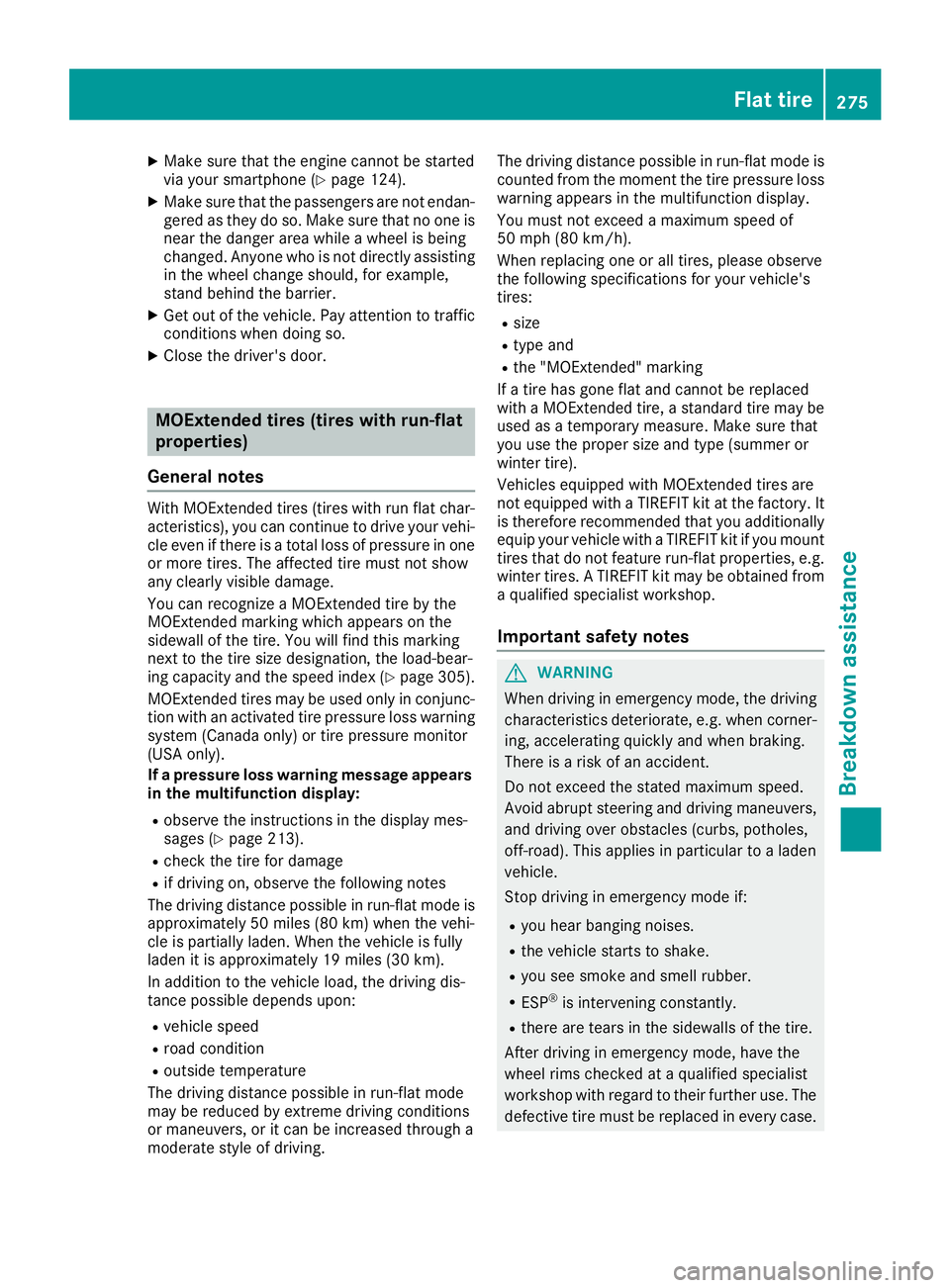
X
Make surethattheengine cannot bestarted
via your smartphone (Ypage 124).
X Make surethatthepassengers arenot endan-
gered asthey doso. Make surethatnoone is
near thedanger areawhile awheel isbeing
changed. Anyonewhoisnot directly assisting
in the wheel change should,forexample,
stand behind thebarrier.
X Get outofthe vehicle. Payattent iontotraffic
condition swhen doing so.
X Close thedriver's door. MOExtended
tires(tires withrun-flat
proper ties)
General notes With
MOExt ended tires(tires withrunflatchar-
acteristics ),you can cont inue todrive yourvehi-
cle even ifthere isatotal lossofpressure inone
or more tires.Theaffected tiremust notshow
any clearly visibledamage.
You canrecogniz eaMOExt ended tirebythe
MOExt ended marking whichappears onthe
sidewa llof the tire. Youwillfind thismarking
next tothe tire size designation, theload-bear-
ing capacity andthespeed index(Ypage 305).
MOExt ended tiresmaybeused onlyinconj unc-
tion with anactivated tirepressure losswarning
system (Canada only)ortire pressure monitor
(USA only).
If apressur eloss warning message appears
in the multifu nctiondisplay:
R observe theinstruct ionsinthe display mes-
sages (Ypage 213).
R check thetire fordamage
R ifdriving on,observe thefollowing notes
The driving distance possibleinrun-flat modeis
approximately 50miles (80km) when thevehi-
cle ispartially laden.Whenthevehicle isfully
laden itis approximately 19miles (30km).
In addition tothe vehicle load,thedriving dis-
tance possible depends upon:
R vehicle speed
R road condition
R outside temperature
The driving distance possibleinrun-flat mode
may bereduced byextrem edriving condition s
or maneuvers, oritcan beincreased througha
moderate styleofdriving. The
driving distance possibleinrun-flat modeis
counted fromthemoment thetire pressure loss
warning appears inthe multifunction display.
You must notexceed amaximum speedof
50 mph (80km/h).
When replacing oneorall tires, please observe
the following specifications foryour vehicle's
tires:
R size
R type and
R the "MOExt ended" marking
If atire has gone flatand cannot bereplaced
with aMOExt ended tire,astandard tiremay be
used asatemporary measure.Makesurethat
you usetheproper sizeandtype (summer or
winter tire).
Vehicles equippedwith MOExt ended tiresare
not equipp edwith aTIREFIT kitatthe factory. It
is therefore recommen dedthat youadditionally
equip yourvehicle withaTIREFIT kitifyou mount
tires thatdonot feature run-flat properties, e.g.
winter tires.ATIREFIT kitmay beobtained from
a qual ified specialist workshop.
Import antsafety notes G
WARNING
When driving inemergency mode,thedriving
characterist icsdeteriorate, e.g.when corner-
ing, accelerating quicklyandwhen braking.
There isarisk ofan accident.
Do not exceed thestated maximum speed.
Avoid abrupt steering anddriving maneuvers,
and driving overobstacles (curbs,potholes,
off-road). Thisappli esinparticular toaladen
vehicle.
Stop driving inemergency modeif:
R you hear banging noises.
R the vehicle startstoshake.
R you seesmoke andsmell rubber.
R ESP ®
is interven ingconst antly.
R there aretears inthe sidewa llsofthe tire.
Aft erdriving inemergency mode,havethe
wheel rimscheck edataqual ified specialist
workshop withregard totheir further use.The
defective tiremust bereplaced inevery case. Flat
tire
275Breakdown assistance Z
Page 294 of 330
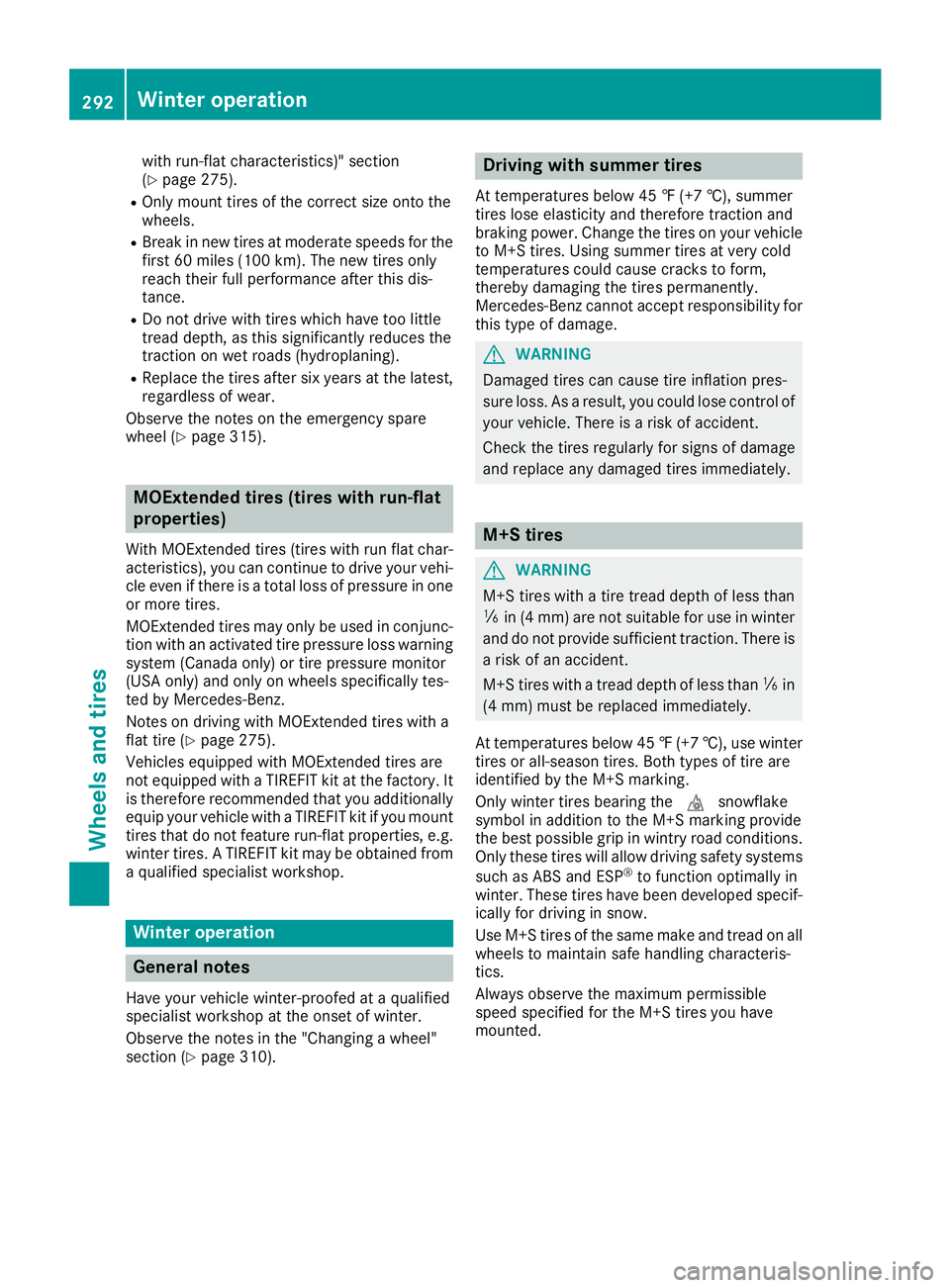
with
run-flat char acterist ics)"sec tion
(Y page 275).
R On lymoun ttir es ofthecor rectsiz eont oth e
wheels.
R Break innew tires atmode ratespeeds forthe
firs t60 miles (100km ).Th ene wtires only
reac hth eir full perf ormanceaft erthis dis-
tan ce.
R Do not drivewith tires which havetoolittle
tr ead dept h,as this sign ificant lyreduc esthe
tr act ion onwet roads (hydro planing).
R Replace thetir es aftersix years atthelates t,
regar dless ofwear.
Obser vethenot eson theemer gencyspare
wheel (Ypage 315). MOExt
ended tires (tir eswith run-f lat
pr oper ties)
With MOExtend edtires (tires with runflatchar -
act erist ics),you can continue todriv eyour vehi-
cle even ifth ere isatot alloss ofpres sure inone
or mor etir es.
MOE xtend edtires may onlybeused incon junc-
tio nwith anact ivat edtirepres sure losswarn ing
syst em(Canada only)ortirepres sure monitor
(US Aonly) andonly onwheels specifically tes-
ted byMerc edes- Benz.
Not eson driv ingwith MOExtend edtires with a
flat tire(Y page 275).
Vehic lesequipped withMOExtend edtires are
not equipped withaTIRE FITkitatthefac tory.It
is theref orerecomm endedthat you addit ionall y
equip yourvehic lewith aTIRE FITkitifyou moun t
tir es that do not feat urerun-flat prope rties, e.g.
wint ertires. ATIRE FITkit may beobt ained from
a qualified specialist workshop. Wint
eroper ation Gener
alnotes
Have yourvehic lewint er-proo fedataqualified
spec ialist workshop attheons etofwint er.
Obser vethenot esinthe"Chang ingawheel"
sec tion(Y page 310). Drivi
ngwith summer tires
At tem perat uresbelow 45‡(+7 †),su mm er
ti re slo se elast icityand theref oretract ion and
brak ingpower .Chan gethetir es on your vehicle
to M+S tires. Usin gsumm ertires atver ycol d
te mper aturescoul dcaus ecr ack sto for m,
th ereb ydamagi ngthetir es perm anently.
Mer cedes-Ben zcan notacc ept respon sibilit yfor
th is type ofdamage . G
WAR
NING
Dam aged tires can caus etir einf lati on pres -
sure loss.As ares ult, you coul dlose control of
your vehicle.Ther eis arisk ofacc iden t.
Chec kth etir es reg ularly forsign sof damage
and replace anydamage dtir es imm ediat ely. M+S
tires G
WAR
NING
M+S tires with atir etread dept hof less than
00CF in(4 mm )are notsuit able foruse inwint er
and donotprov idesuff icienttract ion.Ther eis
a risk ofan acc iden t.
M+S tires with atread dept hof less than 00CF in
(4 mm) must berepl aced immediat ely.
At temper aturesbelow 45‡(+7 †), use winter
tires orall-sea sontires. Bothtypesof tire are
ide ntified bythe M+S marking.
Only winter tiresbearing the004D snowfl ake
symb olinadd ition tothe M+S marking provide
the best possiblegrip inwintry roadconditio ns.
Only these tireswillal low drivi ngsafe tysys tems
such asABS andESP®
to function optimallyin
winter. Thesetires have beendeve lopedspeci f-
ical lyfor drivi nginsnow.
Use M+S tiresofthe same make andtread onall
whe elstomai ntain safehandl ingchara cteris-
tics.
Alwa ysobse rvethe maximu mpermi ssible
spee dspeci fiedforthe M+S tiresyouhave
mounted . 292
Winte
roperatio nWheelsand tires
Page 306 of 330

Permissible
GrossVehicle WeightRating
(GVWR): thegross weight ofthe vehicle, allpas-
sengers, loadandtrailer load/noseweight (if
applicab le)must notexceed thepermissible
gross vehicle weight.
Gross AxleWeight Rating (GAWR): themaxi-
mum permissible weightthatcanbecarried by
one axle (front orrear axle).
To ensure thatyour vehicle doesnotexceed the
maximum permissible values(grossvehicle
weight andmaximum grossaxleweight rating),
have yourloaded vehicle (including driver,occu-
pants, cargo, andfulltrailer loadifapplicab le)
weighed onasuitable vehicleweighbridge. All
about wheelsand tires Uniform
TireQuality GradingStand -
ard s
Overview ofTire Quality GradingStand -
ard s Uniform
TireQuality Grading Standards areU.S.
governmen tspecifications. Theirpurpose isto
provide driverswithuniform reliableinformation
on tire performance data.Tiremanufacturers
have tograde tiresusing threeperformance fac-
tors: 0043tread weargrade, 0044tract iongrade and
0087 temperature grade.Theseregulations donot
apply toCanada. Nevertheless, alltires soldin
North America areprovided withthecorre-
sponding qualitygrading markings onthe side-
wall ofthe tire.
Quality gradescanbefound, whereapplicab le,
on the tire sidewal lbetween treadshoulder and
maximum sectionwidth. Example:
R Tread weargrade: 200
R Tra ction grade: AA
R Temper aturegrade: A
All passenger cartires must confor mto the stat-
utory safety requirements inaddition tothese
grades.
i The
actual values fortires arevehicle-spe-
cific andmay deviate fromthevalues inthe
illustration.
Tread wear The
treadwear gradeisacomparative rating
based onthe wear rateofthe tire when tested
under controlled condition son aspecified U.S.
governmen tcourse. Forexample, atire graded
150 would wearoneandone-half timesaswell
on the governmen tcourse asatire graded 100.
The relative performance oftires depends upon
the actual condition sof their use,however, and
may depart significantly fromthenorm dueto
variations indriving habits, service practices
and differences inroad characterist icsand cli-
mate.
Tra ction G
WARNING
The tract iongrade assigned tothis tireis
based onstraight- aheadbraking traction
tests, anddoes notinclude acceleration, cor-
nering, hydropla ning,orpeak tractionchar-
acteristic s.
! Avoid
wheelspin. Thiscanlead todamage to
the drive train.
The tract iongrades –from highest tolowest –
are AA, A,Band C.Those grades represent the
tire's abilityto stop onwet pavement asmeas-
ured under controlled condition son specified
governmen ttest surfaces ofasphalt andcon-
crete. Atire marked Cmay have poortraction
performance.
The safe speed onawet, snow covered oricy
road isalwa yslower thanondry road surfaces.
You should payspecial attentiontoroad condi-
tions when temperatures arearound freezing
point.
Mercedes-Ben zrecommen dsaminimum tread
depth of00CF in(4 mm) onallfour winter tires. 304
All
about wheelsand tiresWheels andtires
Page 307 of 330

Observe
thelegal lyrequired minimum tiretread
depth (Ypage 291). Winter tirescanreduce the
braking distance onsnow-covered surfacesin
comparison withsummer tires.Thebraking dis-
tance isstill much further thanonsurfaces that
are not icyorcovered withsnow. Takeappro-
priate carewhen driving.
Further information onwinter tires(M+S tires)
(Y page 292).
Temper ature G
WARNING
The temperature gradeforthis tireisestab-
lished foratire that isproperly inflatedand
not overloaded .Exc essive speed, underinfla-
tion, orexcessive loading,either separately or
in combination, cancause excessive heat
buil d-up andpossible tirefailu re.
The temperature gradesareA(the highest), B,
and C,representing thetire's resistance tothe
generation ofheat anditsabil itytodissipa te
heat when tested undercontrolled conditions
on aspecified indoorlaboratorytestwheel. Sus-
tained hightemperature cancause thematerial
of the tire todegenerate andreduce tirelife, and
excessive temperature canlead tosudden tire
failu re.The grade Ccorresponds toalevel of
performance whichallpassenger cartires must
meet under theFederal MotorVehicle Safety
Standard No.109. Grades Band Arepresent
higher levelsofperformance onthe labora tory
test wheel thantheminimum requiredbylaw. Tire
labeli ng
Overview 0043
Uniform TireQuali tyGradi ngStandards
(Y page 309)
0044 Department ofTransportation, TireIdentifi-
cation Number (Ypage 308)
0087 Maximum loadrating (Ypage 307)
0085 Maximum tirepressures (Ypage 296)
0083 Manufacturer
0084 Tire material (Ypage 308)
006B Tire size designation, load-bearingcapacity
and speed rating(Ypage 305)
006C Load index (Ypage 307)
006D Tire name
The markings described aboveareonthe tire in
addition tothe tire name (sales designation) and
the manufacturer's name.
i Tire
data isvehicle-specific andmay deviate
from thedata inthe example.
Tire size designation, load-bearing
capacity andspeed rating G
WARNING
Exc eeding thestated tireload-bea ringcapa-
city and theapproved maximum speedcould
lead totire damage orthe tire bursting. There
is arisk ofaccident.
Therefore, onlyusetiretypes andsizes
approved foryour vehicle model.Observe the All
about wheelsand tires
305Wheels andtires
Z